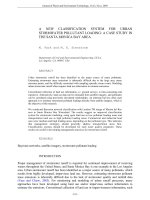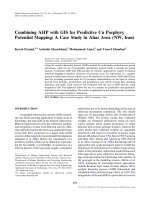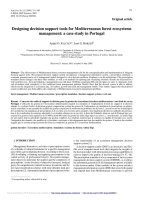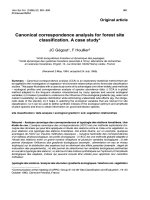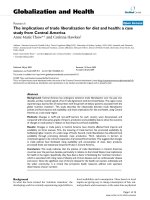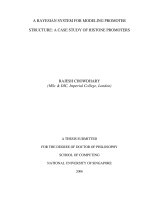Design an experiment using passive sampling technique for monitoring heavy metals: a case study in Nhue river, Vietnam
Bạn đang xem bản rút gọn của tài liệu. Xem và tải ngay bản đầy đủ của tài liệu tại đây (269.14 KB, 5 trang )
Journal of Science & Technology 134 (2019) 069-073
Design an Experiment Using Passive Sampling Technique for Monitoring
Heavy Metals: A case study in Nhue river, Vietnam
Dao Duy Nam, Ton Thu Giang*, Tran Thanh Chi
Hanoi University of Science and Technology – No. 1, Dai Co Viet Str., Hai Ba Trung, Ha Noi, Viet Nam
Received: August 16, 2018; Accepted: June 24, 2019
Abstract
Passive sampling (Chemcatcher) was applied to monitoring several heavy metals (Cd, Cu, Zn and Ni) in
Nhue river (Vietnam). (1) The experiment was investigated sampling rate (Rs, Lh-1) of Chemcatcher defined
as the equivalent volume of water extracted per unit time which is affected by temperature and turbulence
suitable for Vietnam condition, temperature (25 and 35oC) and stirring speed (40 and 60 rpm) were
performed in controlled-flow conditions. Results of the sampling rate (Rs) were 0.0092-0.0179 Lh-1, 0.00420.0268 Lh-1, 0.0063-0.0231 Lh-1 and 0.0067-0.0205 Lh-1 for Cd, Cu, Zn and Ni, respectively. (2) Two
locations on Nhue river was conducted in parallel with spot water sampling in 24- and 72-hours field
deployment. Chemcatcher sampling results were showed time-weighted average (TWA) water
concentration, 0.023-0.045 µg/L in two sampling points for Cadmium and 16.95-62.17 µg/L, 9.74-35.71 µg/L
for sampling point NM1, NM2 of Zinc, respectively. The method showed that measures only the labile
fraction of heavy metals in water as known understanding clearly of bioavailable, bioaccumulation and
toxicity of heavy metals rather dissolved or total of heavy metals.
Keywords: Passive sampling, heavy metals monitoring, Chemcatcher monitoring
1. Introduction1
receiving phase with a high affinity for the pollutants
of interest separated from the external aquatic
environment by a thin diffusion membrane. In most
cases, uptake of analytes base on Fick’s first law [2].
Passive samplers have several advantages over
conventional water monitoring methods: (a) they
enable the estimation of the time-weighted average
(TWA) water concentration of a compound over the
deployment period, (b) in some cases the amount of a
chemical accumulated by the device reflects the
concentration of the freely dissolved and labile
fraction that is assumed to be the most readily
bioavailable; compounds bound to suspended matter
or dissolved organic carbon are generally not
accumulated [3]. Although passive sample technique
is very popular in European countries, but it is very
new in Asian countries. Because of this, the study
applied the technique to investigate the capacity of
application in Vietnam or Asian countries. Besides,
this study can also be considered as the first research
conducted to closely investigate the presence of
heavy metals in surface water in Nhue river
(Vietnam) by passive sampling method. The
performance of the Chemcatcher sampler was tested
under controlled conditions of temperature, pH and
turbulence of water to assess the effect of these
parameters on the uptake kinetics which known
sampling rate (Rs). The sampler was conducted at
two places in Nhue river (Vietnam). The range of
time-weighted average (TWA) concentrations of Cd,
Cu, Zn and Ni using the sampler were compared with
values of spot water samples taken during the trial to
assess
the
utility
of
the
device.
According to study, sampling and sample
preparation typically account for 70-90% of analysis
time [1]. Certainly, sampling is one of the most
important steps of any monitoring procedure. Any
error taken place in this period will be very difficult
to correct and can eventually cause irreversibly
effects to analysis. Traditionally discrete grab spot or
bottle sampling of water is the most common method
of monitoring of heavy metals in surface water.
However, this method has the following
disadvantages: such as measuring total pollutants’
concentration which maybe not assess accurately
whether harmful or not; fee for sampling is high
because need a lot of manpower and transportation;
and provides only a ‘snapshot’ of pollution at the
instant of sampling and may not be representative due
to the fluctuation of pollutants’ concentration. To
overcome these difficulties, various techniques have
been developed and applied internationally to
complement spot sampling for heavy metals
monitoring.
Passive sampling is capability to cover long
sampling periods and indicate time average
concentration values of contaminants. Generally, a
passive sampler device will take only sample a
fraction of the total analyte present; freely dissolved
species and labile complexes as well as conjugated
species. Most designs of passive sampler consist of a
1
Corresponding author: Tel.: (+84) 33 254 3001
Email:
69
Journal of Science & Technology 134 (2019) 069-073
Fig. 1. Chemcatcher sampler, Experiment setup and sampling
remove any contamination by trace metals, immerse
the diffusion-limiting cellulose acetate (CA)
membrane in 1% HNO3 for 30 minutes. Then
thoroughly rinse the membrane with ultrapure water
and store in a Petri dish [7].
2. Material and Methods
2.1. Chemicals and reagents
Reagents were analytical grade or better purity.
Ultrapure MilliQ water (waterPro PS Polishing
systems US) was used throughout. A standard stock
solution (Merck, Darmstadt, Germany) 1.0 gL-1 as
Cd, Cu, Zn and Ni was used for stock solution by
dissolving appropriate amounts in 1% HNO3 (65%,
w/v Merck, Germany). A stock solution (10 mgL-1)
was prepared in 1% HNO3 and stored in amber glass
bottles at 4oC in the dark. Working solutions were
prepared daily by appropriate dilution of the stock
solution. Method US EPA Method 200.8 was applied
for analysis Cd, Cu, Zn and Ni by using Perkin Elmer
Elan DRC-E ICP Mass spectrometer (US).
2.2.3. ChemcatcherTM sampler
In the Chemcatcher sampler, sampler bodies
retain both the receiving phase and diffusion
membrane. For all configurations tested, the diffusion
membrane was placed on the top of the conditioned
Chemcatcher receiving phase disk avoiding formation
of air bubbles between the two layers. The PTFE was
shown to be free of contamination by heavy metals
[8].
2.3. Flow-through exposure tank experiments
The flow-through exposure tank was described
as Fig. 1. The stirring system was placed in a barrel
tank (approx. 50-liters volume), which in turn was
placed in a large external tank (approx. 180 liters).
The external tank was filled with water and
connecting a thermo-regulated-immersion heater
(PolyScience SD07H170- US) to keep the
temperature stable at the desired levels of 25 and
35oC controlled temperature. The ionic strength as
regulated by adding 10 mL NaNO3 and pH was
adjusted to 6.5-7.0 using NaOH. to keep
homogeneous conditions, the water was gently stirred
(Heidolph overhead stirrer, type RZR-2000,
Germany).
2.2. Materials of construction and sampler design
Kingston et al.[4] and Persson et al.[5]
developed a passive sampler, known as Chemcatcher,
for the measurement of TWA concentrations of a
range of organic compounds and metals in different
aquatic environments. Chemcatcher sampler device
includes three parts: Chemcatcher body, chelating
empore disk (receiving phase) and cellulose acetate
membrane.
2.2.1. Receiving phase
Chelating EmporeTM disk (47 mm diameter, 0.5
mm thickness) containing 90% iminodiacetate
functionalized
SDB
and
10%
PTFE
(Polytetrafluoroethylene) were from 3M (United
States) [6]. The disks were washed with 20 mL of 3.0
M nitric acid (ultrapure for trace metal analysis)
followed by two washes with 50 mL ultrapure water.
To convert the chelating EmporeTM disk into the
active ammonium form add 100 mL of 0.1 M
ammonium acetate buffer at pH 5.3 followed by
several washes with ultrapure water [7]. Disks were
stored in a Petri dish and kept damp until use.
Besides, the four test solutions were prepared
by mixing and diluting the standard metal solutions
(Cd, Cu, Zn and Ni) with concentration 1000 mg/L
(Merck, Germany) and de-ionized water for solution
design.
At the beginning of the exposure the prepared
passive sampler (5 samplers per calibration) were
attached to the turntable as Figure 1 and immersed in
the exposure tank. The turntable was the attached to
an overhead stirring motor, which was keep turntable
rotating at 40 and 60 rpm. The deployment of the
Chemcatcher in the lab shown in Table 1.
2.2.2. Diffusion membranes
Cellulose acetate (CA) (47 µm diameter,
0.45µm pore size, 152 µm thicknesses) was
purchased from Portsmouth University, UK). To
70
Journal of Science & Technology 134 (2019) 069-073
Table 1. Calibration curve fits and estimated sampler uptake rate (Rs) for several heavy metals at different
temperature and water turbulence in the flow-through tank. Four tests were retrieved after 4, 8, 24, 48 and 72
hours of exposure.
Parameters
Water temperature (0C)
Rotation speed (rpm)
Flow rate (l/min)
Slope (µg/h) Cd
Regression coefficient (R2) Cd
Sampling rate Rs (Lh-1) of Cd
Slope (µg/h) Cu
Regression coefficient (R2) Cu
Sampling rate Rs (Lh-1) of Cu
Slope (µg/h) Zn
Regression coefficient (R2) Zn
Sampling rate Rs (Lh-1) of Zn
Slope (µg/h) Ni
Regression coefficient (R2) Ni
Sampling rate Rs (Lh-1) of Ni
Test 1
25
40
0.275
0.4664
0.991
0.0147±0.0031
0.1515
0.9397
0.0268±0.0155
0.7564
0.991
0.0231±0.0086
0.4625
0.9896
0.0134±0.0027
Receiving phase:
Chelating Empore disk
Cleaning step: HNO3 10%
Conditioning: Ammonium acetate
buffer (pH 5.3) + water
Test 2
25
60
0.275
0.568
0.9867
0.0179±0.0022
0.1252
0.9809
0.0222±0.0057
0.6319
0.981
0.0193±0.0091
0.4422
0.9879
0.0128±0.0017
CHEMCATCHER
Test 3
35
40
0.275
0.2911
0.9643
0.0092±0.0021
0.0722
0.9708
0.0128±0.0033
0.4274
0.7239
0.0130±0.0316
0.23
0.9541
0.0067±0.0023
Test 4
35
60
0.275
0.5166
0.9911
0.0101±0.0002
0.1694
0.9976
0.0042±0.0011
0.401
0.9662
0.0063±0.0076
0.4924
0.9848
0.0205±0.0035
Diffusion Membrane:
Cellulose acetate membrane
Calibration
Field trial
Flow-through tank conditions: Temperatures;
Stirring rate; flow rate; concentration of heavy
metals; Sampler retrieval: 0, 4, 8, 24, 48, 72 hours
Deployment period: 24 hour or 72 hours; water
conditions: Temperature, pH and observed
turbulence
Receiving phase analysis: mD and m0
Receiving phase analysis, mD: Extraction: 30
ml HNO3 3M; Analysis: ICP-MS
Time weighted average water concentration
(TWA) estimation: Cw=(mD-m0)/RsT
Sampling rate for each condition:
Rs=slope/Cw(Lhour-1)
Fig. 2. Analytical protocol for calibration and field trial studies
2.4. Extraction Chemcatcher sampler
2.5. Field trial location and analysis of water
samples and extracts
Extraction after exposure was conducted in
vacuum filtration equipment, where the receiving
phase disk was extracted using 30 mL 3M HNO3. The
extract was collected and analysis using ICP-MS
equipment [7]. As a quality control measure
procedure, field blanks were used. Procedural blank
passive samplers were prepared and treated as
A field trip was conducted in Nhue river
consists of two sampling locations: First sample
(NM1) at the intersection between To Huu street (Ha
Dong) and Nhue river with coordinate (20.988678,
105.780493), second sample (NM2) at the White
bridge Quang Trung street (Ha Dong) with coordinate
(20.974233, 105.780424). The sampling locations
were selected based on the influence of wastewater
discharged from households and craft village
described above. Field blanks were brought to
and opened in the field at the sampling location.
71
Journal of Science & Technology 134 (2019) 069-073
activities, so that concentration of metals could
change over time. Chemcatcher devices were
deployed at sampling sites in periods of 72 hours for
NM1 and 24 hours for NM2 to monitor concentration
of Cadmium, Copper, Zinc and Nickel in surface
water. The deployment devices were suspended
below surface of the river water at 20-40 cm, then
removed out of river body at the end of sampling
time. Samplers after deployment is retrieve as
following: (a) retrieve samplers and take care not to
touch the surface of the diffusion-limiting cellulose
acetate membrane. Adding river water from the
sampling site to the top of the diffusion-limiting
cellulose acetate (CA) membrane, close the sampler
by the transport lid and immediately seal the sampler
back into the plastic zip-lock bag. (b) transport the
samplers in a cooler, containing cooling bottles, to the
processing laboratory, (c) store the Chemcatcher in a
refrigerator at 4oC until processing [7].
from which the sampling rate (Rs) for heavy metals
could be calculated. The table 1 summarizes the
calibration data for each of the four experiments and
the calculated sampling rates (Rs). The results show
that for four experiments RS value (Lh-) for cadmium,
copper, zinc and nickel were 0.0092±0.0021–
0.0179±0.0022, 0.0042±0.0011 - 0.0268±0.0155,
0.0063±0.0076– 0.0231±0.0086 and 0.0067±0.00230.0134±0.0027 respectively.
3.1.2. Chemcatcher application for heavy metals
monitoring in Nhue river
Two sampling sites (NM1 and NM2) in Nhue
river were selected for deployment at 72 hours and 24
hours, respectively. Spot water samples were taken at
0, 4, 8, 24, 48 and 72 hours for NM1 and 0, 4, 8, 24
hours for NM2, preservation and transportation to the
Lab for heavy metal analysis. The water temperature
was 30, 28, 28.5, 27.5 and 25oC at NM1, 30, 28 and
28.5oC at NM2 and water pH around 6.8-7.2 for two
sampling points.
Together with the Chemcatcher deployment, six
and four spot water samples (200 mL) were collected
from NM1 and NM2 at 0 hour, 4 hours, 8 hours, 24
hours 48 hours, 72 hours and 0 hour, 4 hours, 8 hours,
24 hours respectively. Samples were collected,
preserved and transported to the laboratory for
analysis.
At two sampling sites, spot water was taken and
measured total Cd, Cu, Ni and Zn. However, the
concentration of Cu and Ni were lower detection of
analysis method (Cu concentration is lower 10 µg/L
and Ni concentration is lower 1 µg/L). For
concentration of Cd and Zn are shown in Table 2.
The results of spot samples are demonstrated that
concentration of Cd is quite low and stable. However,
concentration of Zn is higher and quite flexible. The
results can be explained at the sampling sites where
waste water (contained zinc) may be discharged by
households or craft village activities
3. Results and discussion
3.1. Results
3.1.1. Calibration of Chemcatcher in controlled tank
According to K.Booij et al [9] the uptake of a
Chemcatcher into a sampler can be divided into three
stages: Linear, curvilinear and finally equilibrium
stage. During initial deployment accumulation is
approximately linear. At this stage, the mass of
analyte in the receiving phase is directly proportional
to the concentration to which the system has been
exposed, deployment time and effective sampling rate
(Rs); following the equation: MD= m0 + CwRst
Where mD: Mass of target analyte accumulated
in the receiving phase, m0: initial mass of the analyte
in the receiving phase, Cw: TWA analyte
concentration in water, Rs: Effective sampling rate of
the device and t: deployment time.
The mass of Cd and Zn found in the receiving
phase of Chemcatcher after deployment at the two
sampling points and the estimated TWA
concentrations interval (Cw) are given in table 2. The
temperature water was 25oC to 30oC and the
turbulence of the river water during this season was
assumed to be equivalent to the 40 - 60 rpm
turbulence of the calibration tank experiments.
Therefore, for TWA estimated concentration, Rs
value in the range 0.0092- 0.0179 L hour-1 for Cd and
0.0063- 0.0231 L hour-1 for Zn was used.
To assess the effects of temperature and
turbulence on the performance of Chemcatcher for
the sampling of Cadmium, Copper, Zinc and Nickel,
samplers were deployed in the calibration tank for up
to 72 hours at two levels of water temperature (25oC
and 35oC) and two levels of water turbulence (40 and
60 rpm) for combine Cadmium, Copper, Zinc and
Nickel in the solution and flow rate of water at 0.275
L/min. After exposure, the amount of analyte (mD)
accumulated in the receiving phase was measured.
Each calibration experiment yielded an uptake curve
Chemcatcher sampling technique was applied to
measure the labile or free metals content while bottle
sampling technique was used to measure the total
metals content in surface water at Nhue river. That’s
why concentration of heavy metals measured by
Chemcatcher was much lower than that found in spot
samples collected over the same period. For the
research, the results showed that Zn concentration
obtained at NM1 and NM2 for Chemcatcher method
was 11.05-40.09% and 10.52-38.60% compared to
the spot sampler technique. In addition, the ratio of a
72
Journal of Science & Technology 134 (2019) 069-073
free metal ion content to a total concentration of the
corresponding metal was used to assess the free and
labile fraction of the total content of metal ions, and
then, the one that response to the bioavailability and
toxicity of presence of the metals in the water
environment.
obtained at NM1 and NM2 for Chemcatcher method
was 11.05-40.09% and 10.52-38.60% compared to
the spot sampler technique.
In summary, application of the method provides
more data for revive and assessment of water quality.
However, it should be applied and expanded to
supplement data of sampling rate of method (Rs
value) and results in other water sources.
Table 2. Concentration of heavy metals in spot water
samples collected at first and second sampling sites
during passive sampling and mean concentration of
Cadmium and Zinc;
DP
(h)
SS
Acknowledgments
This research is funded by the Hanoi University
of Science and Technology (HUST) under project
number T2017-PC-013. The authors gratefully
acknowledge Hanoi University of Science and
Technology (HUST) for providing financial support
for this research project.
Mean concentration of Cd and
Spot water samples Zn was applied by Chemcatcher
sampling
Cd
Zn
(µg/L)
(µg/L)
0
NM10
1
110
4
NM11
<1
70
8
NM12
<1
50
24
NM13
<1
30
48
NM14
<1
40
72
NM15
7
620
0
NM20
7
110
4
NM21
<1
70
8
NM22
<1
140
24
NM23
<1
50
Cd (µg/L)
Zn (µg/L)
Rs (Lhour-1): Rs (Lhour-1):
0.0092- 0.0179 0.0063- 0.0231
References
Mass: 0.03
(µg/disk)
TWA:
0.023-0.045
(µg/L)
Mass: 28.2
(µg/disk)
TWA:
16.95-62.17
(µg/L)
Mass: 0.03
(µg/disk)
TWA:
0.023-0.045
(µg/L)
Mass: 16.2
(µg/disk)
TWA:
9.74-35.71
(µg/L)
[1]
Tadeusz Górecki, Jacek Namiésnik, Trends in
analytical chemistry, 21, 4, (2002), 275 -291
[2]
R.Greenwood, G.Mills, B.Vrana, Passive sampling
techniques in environmental monitoring, Wilson &
Wilson's Volume 48, (2007)
[3]
Rocío Aguilar-Martíneza, M. Milagros GómezGómeza, Richard Greenwood, Graham A. Millsc,
Branislav Vranab, María A. Palacios-Corvill., Talanta
77, (2009), 1483-1489
[4]
Kingston, Jenny K.; Greenwood, Richard; Mills,
Graham A.; Morrison, Gregory M.; Björklund
Persson, Lena, Journal of Environmental Monitoring,
Volume 2, 5, (2000), 487-495
[5]
Persson, Lena Björklund; Morrison, Gregory M.;
Friemann, Jens-Uwe; Kingston, Jenny; Mills,
Graham; Greenwood, Richard, Volume 3, 6, (2001),
639-645
[6]
3M Co-operation group., Empore extraction Disks,
1996
[7]
Graham A. Mills et al., The Chemcatcher device for
sampling metals, University of Portsmouth, 2012
[8]
R.Greenwood, G.Mills, B.Vrana., Comprehensive
analytical chemistry Volume 48, 2007.
[9]
K. Booij, B. Vrana, J.N. Huckins, in: R. Greenwood,
G.A. Mills, B. Vrana, D. Barceló, Comprehensive
Analytical Chemistry, volume. 48, Elsevier,
Amsterdam, (2007), 251–278.
DP (h): Deployment Periods (hour), SS: Sampling sites
4. Conclusion
Passive sampling (Chemcatcher) method applied
in Vietnam is the preliminary step for application of
new sampling method to evaluate the feasibility of
the implementation in Vietnam, especially for
sampling for labile or free metals. In the research,
four tests were done in the calibration tank with two
levels of water temperature (25 and 35oC) and two
levels of water turbulence (40 and 60 rpm) and the
results show that the value of sampling rate (RS) (Lh-)
for cadmium, copper, zinc and nickel were
0.0092±0.0021 - 0.0179±0.0022, 0.0042±0.0011 0.0268±0.0155, 0.0063±0.0076 - 0.0231±0.0086 and
0.0067±0.0023 - 0.0134±0.0027, respectively. Two
sampling positions in Nhue river was choose for
applied Chemcatcher sampling and spot sampling.
Two metals Cu and Ni for results lower detection of
ICP-MS method. However, Zn concentration
73
